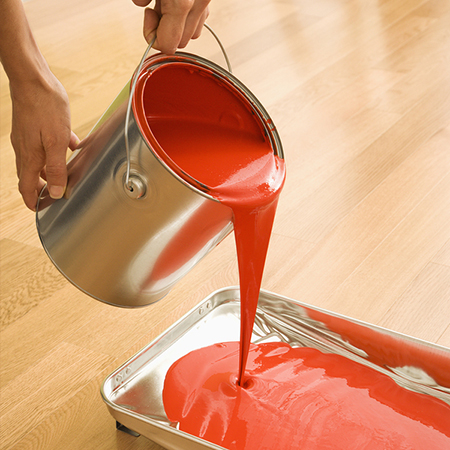Do-it-yourself tips rarely include a painting technique called “cutting-in,” but it’s one of the secrets of professional painters. Some of the most time-consuming prep tasks are eliminated with this approach to painting edges that are too tight for a paint roller. A paintbrush, a steady hand, and confidence are all you need. The following tips could help you become a master at cutting-in.
 What is Cutting-In?
What is Cutting-In?
No need to use painter’s tape or masking tape, when you paint edges by cutting-in. Instead, lines of paint are manually drawn alongside areas that aren’t being painted, such as at the ceiling line, in corners, and along trim and baseboards.
Benefits of Cutting-In
One of the reasons professional painters do exceptional work quickly is because of the cutting-in technique. It’s a huge time-saver when you don’t have to use painter’s tape in all the places where cutting-in can be used. This is just one of the benefits, and the following are a few more:
- The cost of painting is reduced when you don’t need to buy painter’s tape, which is expensive.
Because prep is minimal, painting can begin much more quickly. - When you use painter’s tape, you have to wait until paint dries before you can remove the tape. This waiting time is eliminated.
- Note that a potential downside to cutting-in is that mistakes can be costly because they can be difficult to cover up. For instance, it’s tough to hide it when colored paint gets onto white trim.
Steps for the Cutting-In Painting Technique
The reality is that cutting in is far from easy. In fact, mastering the technique is very difficult. If the extent of your experience with painting is limited to a few rooms in the coming years, the best advice for you is to go ahead and buy the painter’s tape. If you expect to paint more than one entire home interior in the near future, it may be well worth your while to learn how to use the cutting-in technique for painting around trim and edges, as follows:
- The first step is to get the tools you need for cutting in. Professional painters recommend getting a cut bucket and an angled brush about 2 1/2-inches wide, which is also called a “sash brush.” If you are painting windows or small woodwork, get a smaller sash brush. A cut bucket is a paint bucket or any sturdy plastic bucket with no lip. If there is a lip, it allows paint to accumulate on the brush. A lip on the bucket would give you more paint on the brush that what you need for this technique.
- Consider buying paint conditioner to mix in with water-based paint. Conditioner or paint extender gives painting a smoother flow, making it easier to achieve a crisp, straight line.
- Put some painter’s tape or masking tape on a wall and spend some time practicing the cutting-in technique next to the line.
To begin painting, pour about an inch or two of paint in the cut bucket.
- Dab about an inch of paint onto the paintbrush and pat it against opposite sides of the bucket.
- You need to be able to see clearly, to accurately paint a cut-in line. Before you start painting, be sure the light is bright. You can wear a headlamp, if needed.
- Sweep a line of paint along the area where the cut-in technique will be used. This unloads some of the paint. On a second pass, fan the bristles so that the tip of the taper paints a line along the edge. Make a third pass, to straighten the line, if needed.
- For mistakes, keep one layer of a damp cloth wrapped around a putty knife. As soon as the error is made, slide the putty knife with cloth along that spot, to wipe it off before it has had time to set. Once paint begins to dry, fixing the error will require more steps to correct.
- After the cut-in line is complete, drag the bristles lightly over the outside edge of the line, without adding more paint. This way, when you start using a roller, the cut-in painting won’t look like a stripe
Consult with Professionals
Having second thoughts about do-it-yourself painting? You can always contact the experts at Franklin Painting, if you are in Connecticut anywhere near or around Farmington and want quality interior or exterior painting. Our professional painters can be reached at 877-646-7774. They are all skilled and experienced; and all have mastered every type of painting method needed for a wide range of faux painting projects, in addition to the cutting-in technique.

Frank Campanelli, the esteemed founder of Franklin Painting LLC, has been leading the company since 1986. He takes immense pride in the stellar reputation his dedicated team has built by consistently delivering top-notch service to each customer.


 To begin painting, pour about an inch or two of paint in the cut bucket.
To begin painting, pour about an inch or two of paint in the cut bucket.